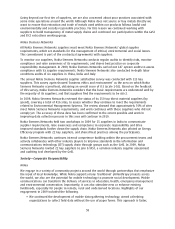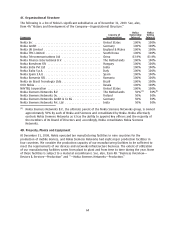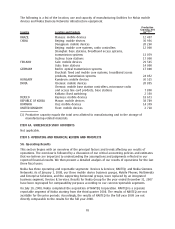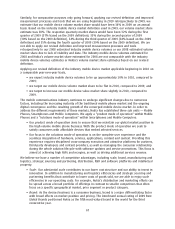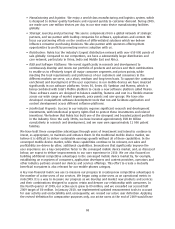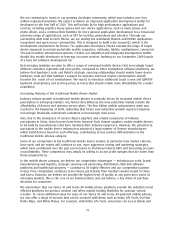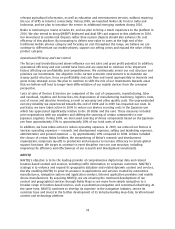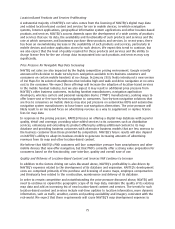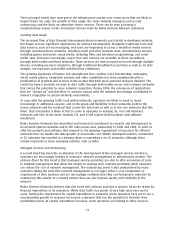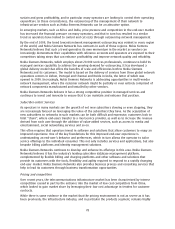Nokia 2009 Annual Report Download - page 70
Download and view the complete annual report
Please find page 70 of the 2009 Nokia annual report below. You can navigate through the pages in the report by either clicking on the pages listed below, or by using the keyword search tool below to find specific information within the annual report.•
Manufacturing and logistics:
We enjoy a worldclass manufacturing and logistics system, which
is designed to deliver quality hardware and respond quickly to customer demand. During 2009,
we made over one million devices per day in our nine main device manufacturing facilities
globally.
•
Strategic sourcing and partnering:
We source components from a global network of strategic
partners, and we partner with leading companies for software, applications and content. We
focus our partnering efforts on the creation of differentiated solutions which we believe
influence consumer purchasing decisions. We also partner with operators offering them
opportunities to profit by promoting services adoption with us.
•
Distribution:
Nokia has the industry’s largest distribution network with over 650 000 points of
sale globally. Compared to our competitors, we have a substantially larger distribution and
care network, particularly in China, India and Middle East and Africa.
•
R&D and Software Platforms:
We invest significantly in research and development to
continuously develop and renew our portfolio of products and services and their combinations
to enable us to effectively target all major consumer segments and prices points, while
meeting the local requirements and preferences of our customers and consumers in the
different markets we serve, on a short, medium and longterm basis. To support the continued
enrichment and development of the user experience in our mobile devices we have invested
significantly in our software platforms: Series 30, Series 40, Symbian and Maemo, which is
being combined with Intel’s Moblin platform to create a new software platform called MeeGo.
These software assets are designed to balance usability, features and cost in a flexible manner
across our wide range of market segments, price points and user groups. We have also
developed crossplatform software development tools that run and facilitate application and
content development across different software platforms.
•
Intellectual Property:
Success in our industry requires significant research and development
investments, with intellectual property rights filed to protect those investments and related
inventions. We believe that Nokia has built one of the strongest and broadest patent portfolios
in the industry. Since the early 1990s, we have invested approximately EUR 40 billion
cumulatively in research and development, and we now own approximately 11 000 patent
families.
We have built these competitive advantages through years of investment and intend to continue to
invest, as appropriate, to maintain and enhance them. In the traditional mobile device market, we
believe it is difficult to deliver sustainable earnings growth without all of these capabilities. In the
converged mobile device market, while these capabilities continue to be relevant, net sales and
profitability are driven by other, additional capabilities. Innovations that significantly improve the
user experience are a key competitive factor in the converged mobile device market, and, as discussed
below, we expect to deliver improvements to our user experience in 2010. We are also focused on
building additional competitive advantages in the converged mobile device market by, for example,
establishing an ecosystem of consumers, application developers and content providers, operators and
other industry partners around our devices and services offerings. This effort to create a mutually
beneficial ecosystem is also relevant for our mobile phones category.
A key nonfinancial metric we use to measure our progress in creating new competitive advantages is
the number of active users of our services. We began using active users as an operational metric in
mid2009. It is a way to measure our progress as we develop and market new products and services
and their combinations designed to acquire, retain and deepen our relationship with consumers. In
the fourth quarter of 2009, our active users grew to 89 million, and we exceeded our second half
2009 target of 80 million. In January 2010, we implemented updated measurement tools to account
for user activity and contactability and, consequently, we revised our active user definition. Applying
the revised definition for comparative purposes only, our active users at the end of 2009 would have
68


